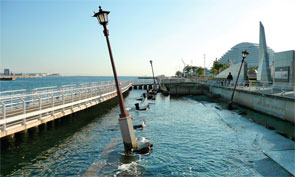
A view of the Kobe Earthquake Memorial Park, where a piece of the harbor is being left untouched in its wrecked state.
Image Credit: J. Aa./shutterstock.com
In late February 2011, a 68-year-old woman visited the rheumatology outpatient clinic. She had been congenitally healthy and had been a field athlete in her early days. Beginning in early January 2011, she became aware of pain in her neck and both shoulders, with pain spreading to her lower back and thighs. She also became aware of general malaise, fever and weight reduction, with difficulties in walking unassisted and changing clothes. Her inflammatory response was at a high level, and her creatinine kinase was within the normal range; further, her rheumatoid factors were negative. Therefore, I diagnosed her as having polymyalgia rheumatica (PMR), initiated administration of 20 mg of prednisolone and instructed her to visit the clinic again in two weeks.
Her symptoms improved dramatically after administration of prednisolone, and her ability to walk returned on the second day after administration. Her symptoms continued to improve over the first week, and she regained the ability to run.
The Great East Japan Earthquake occurred on the 10th day postadministration and a tidal wave (tsunami) hit her residence. She was with her 1-year-old grandchild at home on the day of the earthquake. She noticed the tsunami approaching and ran with her whole energy, holding her grandchild in her arms. Her house was swallowed up by the tsunami; she was able to avoid it by ascending stairs.
She visited a hospital near the shelter she went to and was instructed to reduce her prednisolone; the joint pains in her shoulders, hands and wrists, returned after the reduction, and she was ultimately diagnosed as having elderly onset rheumatoid arthritis (EORA). Currently, she is being treated with methotrexate.
EORA is often accompanied by weight reduction and muscle pain. Differentiating it from PMR can be difficult due to the lower levels of RF compared with conventional RA.1–5 I consequently misdiagnosed her case of EORA as PMR. The unintended consequence of the misdiagnosis was the rapid improvement of her symptoms due to the prednisolone, without which, she would not have been able to run when the tsunami hit. If I had diagnosed her case as RA and treated her with methotrexate, she and her grandchild would not have been able to avoid the tsunami. The patient understood the impact of the prednisolone treatment and sent a grateful letter to me. This is the first letter of gratitude I have received after a misdiagnosis.
Hiroshi Watanabe, MD, PhD, Professor, Department of Gastroenterology and Rheumatology, Fukushima Medical University, Fukushima, Japan
References
- Inoue K, Shichikawa K, Nishioka J, et al. Older age onset rheumatoid arthritis with or without osteoarthritis. Ann Rheum Dis. 1987;46:908–911.
- Mavragani CP, Moutsopoulos HM. Rheumatoid arthritis in the elderly. Exp Gerontol. 1999;34:463–471.
- Turkcapar N, Demir O, Atli T, et al. Late onset rheumatoid arthritis: Clinical and laboratory comparisons with younger onset patients. Arch Gerontol Geriatr. 2006;42:225–231.
- Caporali R, Montecucco C, Epis O, et al. Presenting features of polymyalgia rheumatica (PMR) and rheumatoid arthritis with PMR-like onset: A prospective study. Ann Rheum Dis. 2001;60:1021–1024.
- Pease CT, Haugeberg G, Morgan AW, et al. Diagnosing late onset rheumatoid arthritis, polymyalgia rheumatica, and temporal arteritis in patients presenting with polymyalgic symptoms. A prospective longterm evaluation. J Rheumatol. 2005;32:1043–1046.


